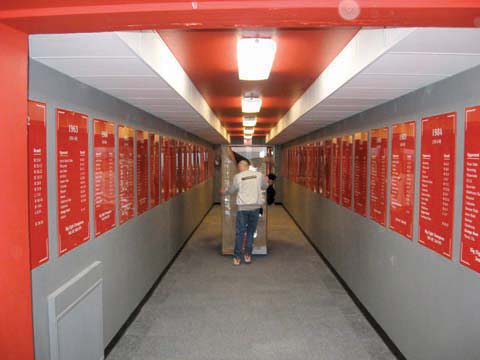| |
|
|

from the issue of February 21, 2008
|

| |
|
|
| |
Research Computing Facility moves into South Stadium

Tunnel Walk of the supercomputers

BY TROY FEDDERSON, UNIVERSITY COMMUNICATIONS
The Alan Parsons Project's "Sirius" did not thunder.

| | 
 
| | | A Von Rentzell employee pushes a rack down the South Stadium hallway that was previously used for the Husker football Tunnel Walk. David Swanson/courtesy photo.

|
Bo Pelini was a no show.

Not one stadium dog was being hawked.

And, still the sound of fans built within South Stadium. Ah, that's the power of Red - not to mention PrairieFire, Merritt and Homestead - coming online.

UNL's supercomputing lineup completed a reverse Tunnel Walk Feb. 12, moving from the Scott Engineering Center to renovated space in the Schorr Center, the former home of Husker football in South Stadium.

"We were going to have 'Sirius' playing on an iPod, but we didn't get that done," said David Swanson, director of UNL's Research Computing Facility. "Our new space was formerly space for laundry and sports medicine. There are still a few odd reminders of what it once was."

What it has become is a place for UNL's supercomputers to expand.

Swanson said PrairieFire was once maintained in a 300-square-foot machine room. The site within the Schorr Center - which is the new home for Computer Science and Engineering - is 2,000 square feet.

"That's more than enough space for PrairieFire, Red, Homestead and Merritt," Swanson said. "And, it gives us room to expand in the future."

PrairieFire - maintained by the Research Computing Facility, which includes Swanson, Tom Harvill, Garhan Attebury, and a handful of student employees - was originally housed in the Miller and Paine Building in downtown Lincoln. However, due to cooling problems and the end of a lease, Swanson said a decision was made to temporarily move PrairieFire and other related components into the Scott Engineering Center.

 
| | MOVING IN - Mako Furukawa installs a network switching interface into the switcher used by Red and PrairieFire. Photo by Troy Fedderson/University Communications.

| |
"That move was good for us," Swanson said. "It was good practice."

So how do you efficiently move hundreds of pounds of disc arrays, dozens of nodes, a handful of racks and an estimated five miles of cables?

"It's a lot like herding cats," Swanson said. "All you can really do is prepare things for the movers. Of course, we label everything possible."

The actual move itself took a few hours as Von Rentzell employees efficiently shifted the computer racks, parts and boxes of cords across campus. The real fun comes in rebuilding the units. That work falls to Swanson's group and the caretakers of Red, Mako Furukawa and Carl Lundstedt.

"We won't really know what we have until everything is hooked up and running," Swanson said. "That's when we'll have to deal with all the little things that can happen."

After working through wiring issues through shared components, the two teams started to break down and reassemble the machines.

"We're able to move things around a bit and make the machines more efficient," said Lundstedt. "We've been putting this type of work off because we knew we could accomplish this through the move."

PrairieFire is primarily used for campus research activities. Red is a supercomputer used primarily by particle-physics research affiliated with the Large Hadron Collider near Geneva, Switzerland. Merritt, a new addition named after the Merritt Reservoir, offers researchers storage of up to 512 gigabytes of RAM.

Upgrades to both Red and PrairieFire are already planned. Swanson said Red will probably be the first to grow, with PrairieFire planning a $250,000 upgrade this year.

The new facility is engineered to handle cooling options for the computers, which Swanson said emit heat on the order of 240,000 BTUs every hour. The facility also includes a walkway for visitors to see the supercomputers in action - Red in the front, PrairieFire and Merritt behind. And, Swanson said the Schorr Center provides for better access all around.

"It's much more convenient for us to be on campus," Swanson said. "If a user wants to come over for a visit, we're right here. And, if we need to service something, we can run downstairs and get to work."

Get to know UNL's Supercomputers
PrairieFire
PrairieFire is the 98 node, 868 gigabyte computer used for researchers across campus. Five years ago, PrairieFire was the 107th most powerful computer in the world. It has tripled in capacity since, but is no longer rated in the top 500. Upgrades this year will double to quadruple the power of PrairieFire.

Red
Red is a 111 node/444 core cluster computer purchased to help analyze data for the CMS particle physics experiment and is currently deployed on the open science grid.

Homestead
Homestead is an Origin 300 supercomputer from SGI containing 32 processors and 24 GB of RAM. The computer is used by researchers in many departments for a wide variety of uses.

Merritt
Named after the Merritt Reservoir, this computer is mainly used as a storage device for campus researchers. Total memory is 10 terrabytes. Each researcher that uses Merritt is allowed access to 512 gigabytes of RAM.

GO TO: ISSUE OF FEBRUARY 21
NEWS HEADLINES FOR FEBRUARY 21
Tunnel Walk of the supercomputers
Chang-Barnes to play with Rastrelli Cello Quartet
Lecture by 'The Green Evangelist' is Feb. 25
Forsberg
Janovy's new book reveals secrets of university success
Teachers College Celebration
UNL scientists study delay in irrigation of soybeans
733093S37890X
|
|
|
|
|
|
|
|